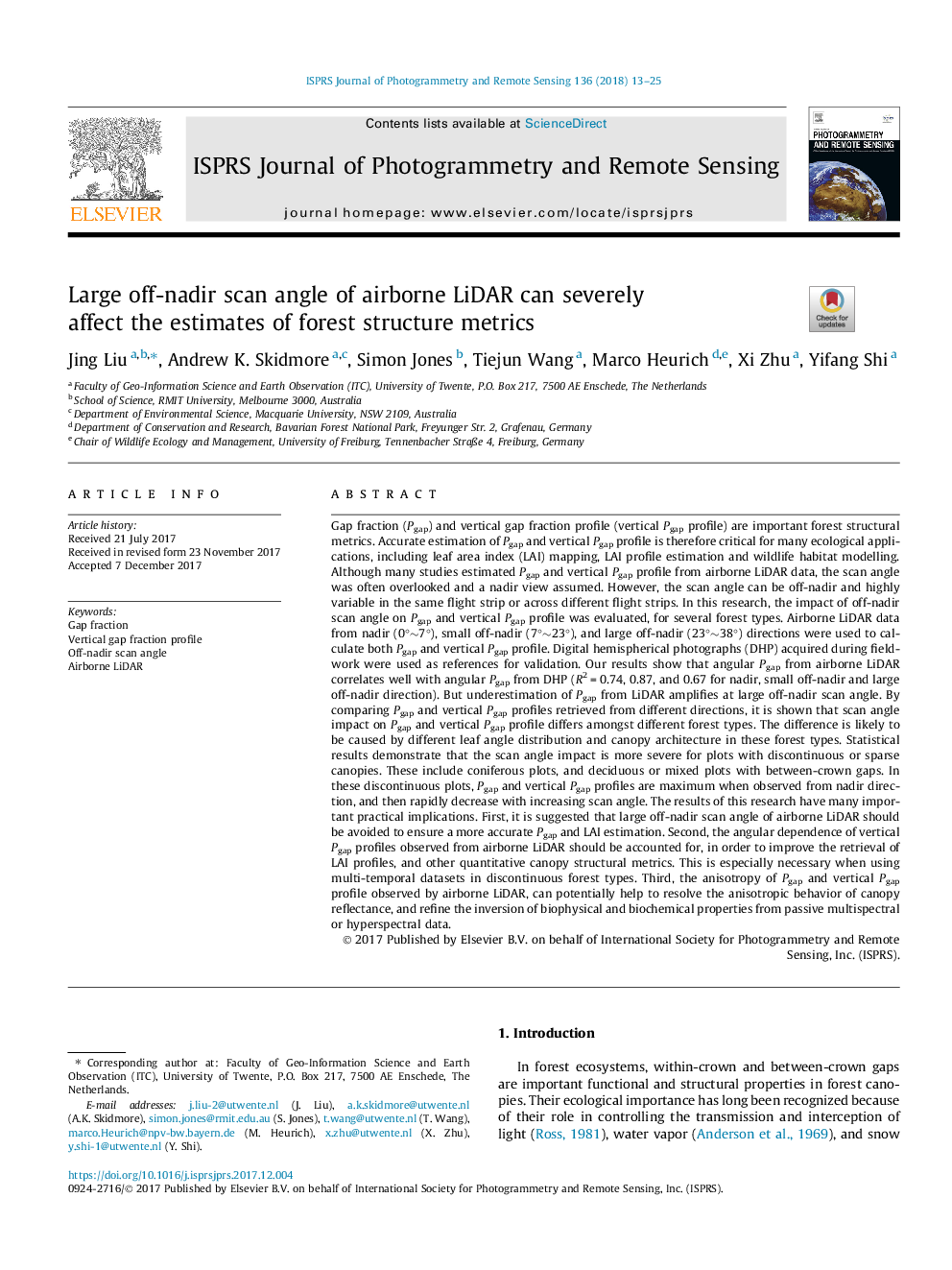| کد مقاله | کد نشریه | سال انتشار | مقاله انگلیسی | نسخه تمام متن |
|---|---|---|---|---|
| 6949235 | 1451238 | 2018 | 13 صفحه PDF | دانلود رایگان |
عنوان انگلیسی مقاله ISI
Large off-nadir scan angle of airborne LiDAR can severely affect the estimates of forest structure metrics
دانلود مقاله + سفارش ترجمه
دانلود مقاله ISI انگلیسی
رایگان برای ایرانیان
موضوعات مرتبط
مهندسی و علوم پایه
مهندسی کامپیوتر
سیستم های اطلاعاتی
پیش نمایش صفحه اول مقاله

چکیده انگلیسی
Gap fraction (Pgap) and vertical gap fraction profile (vertical Pgap profile) are important forest structural metrics. Accurate estimation of Pgap and vertical Pgap profile is therefore critical for many ecological applications, including leaf area index (LAI) mapping, LAI profile estimation and wildlife habitat modelling. Although many studies estimated Pgap and vertical Pgap profile from airborne LiDAR data, the scan angle was often overlooked and a nadir view assumed. However, the scan angle can be off-nadir and highly variable in the same flight strip or across different flight strips. In this research, the impact of off-nadir scan angle on Pgap and vertical Pgap profile was evaluated, for several forest types. Airborne LiDAR data from nadir (0°â¼7°), small off-nadir (7°â¼23°), and large off-nadir (23°â¼38°) directions were used to calculate both Pgap and vertical Pgap profile. Digital hemispherical photographs (DHP) acquired during fieldwork were used as references for validation. Our results show that angular Pgap from airborne LiDAR correlates well with angular Pgap from DHP (R2â¯=â¯0.74, 0.87, and 0.67 for nadir, small off-nadir and large off-nadir direction). But underestimation of Pgap from LiDAR amplifies at large off-nadir scan angle. By comparing Pgap and vertical Pgap profiles retrieved from different directions, it is shown that scan angle impact on Pgap and vertical Pgap profile differs amongst different forest types. The difference is likely to be caused by different leaf angle distribution and canopy architecture in these forest types. Statistical results demonstrate that the scan angle impact is more severe for plots with discontinuous or sparse canopies. These include coniferous plots, and deciduous or mixed plots with between-crown gaps. In these discontinuous plots, Pgap and vertical Pgap profiles are maximum when observed from nadir direction, and then rapidly decrease with increasing scan angle. The results of this research have many important practical implications. First, it is suggested that large off-nadir scan angle of airborne LiDAR should be avoided to ensure a more accurate Pgap and LAI estimation. Second, the angular dependence of vertical Pgap profiles observed from airborne LiDAR should be accounted for, in order to improve the retrieval of LAI profiles, and other quantitative canopy structural metrics. This is especially necessary when using multi-temporal datasets in discontinuous forest types. Third, the anisotropy of Pgap and vertical Pgap profile observed by airborne LiDAR, can potentially help to resolve the anisotropic behavior of canopy reflectance, and refine the inversion of biophysical and biochemical properties from passive multispectral or hyperspectral data.
ناشر
Database: Elsevier - ScienceDirect (ساینس دایرکت)
Journal: ISPRS Journal of Photogrammetry and Remote Sensing - Volume 136, February 2018, Pages 13-25
Journal: ISPRS Journal of Photogrammetry and Remote Sensing - Volume 136, February 2018, Pages 13-25
نویسندگان
Jing Liu, Andrew K. Skidmore, Simon Jones, Tiejun Wang, Marco Heurich, Xi Zhu, Yifang Shi,